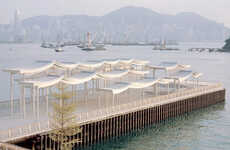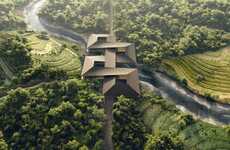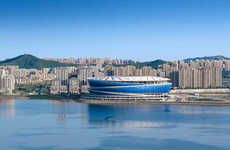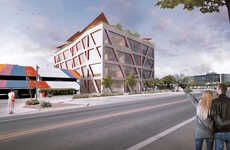The 'Lucky Knot' Bridge in China Was Inspired by the Mobius Strip
Mishal Omar — November 2, 2016 — Art & Design
References: nextarchitects & dezeen
Designed by 'NEXT Architects,' the Lucky Knot bridge is now complete and has been unveiled for public use.
The bridge is located in Changsha, China and from afar, features an almost serpentine quality with its steep curves and multiple thin walkways. It is a bright red in color and offers pedestrians with "a variety of different routes across the Dragon King Harbour River." The Lucky Knot bridge's unique serpentine shape was inspired by the Mobius ring – a band that has only one side and one boundary – as well as Chinese knotting art.
This bridge is truly a feat of architecture and can be appreciated by locals and tourists in the area alike.
The bridge is located in Changsha, China and from afar, features an almost serpentine quality with its steep curves and multiple thin walkways. It is a bright red in color and offers pedestrians with "a variety of different routes across the Dragon King Harbour River." The Lucky Knot bridge's unique serpentine shape was inspired by the Mobius ring – a band that has only one side and one boundary – as well as Chinese knotting art.
This bridge is truly a feat of architecture and can be appreciated by locals and tourists in the area alike.
Trend Themes
1. Curved Pedestrian Bridges - Opportunity for architects and designers to explore innovative bridge designs that offer unique experiences for pedestrians.
2. Serpentine Bridge Architecture - Potential for architects to draw inspiration from serpentine shapes, such as the Mobius strip, to create visually striking and functional bridges.
3. Integration of Cultural Elements in Bridge Design - Chance for designers to incorporate cultural elements, like Chinese knotting art, into bridge designs to create landmarks that reflect local identity.
Industry Implications
1. Architecture - Opportunity for architectural firms to take on innovative bridge projects and showcase their design prowess.
2. Tourism - Potential for the bridge to attract tourists due to its unique and visually striking design, contributing to local tourism industry growth.
3. Urban Development - Chance for urban planners to incorporate creative and iconic bridge designs into urban development plans, enhancing the aesthetics and functionality of cities.
0.9
Score
Popularity
Activity
Freshness






















